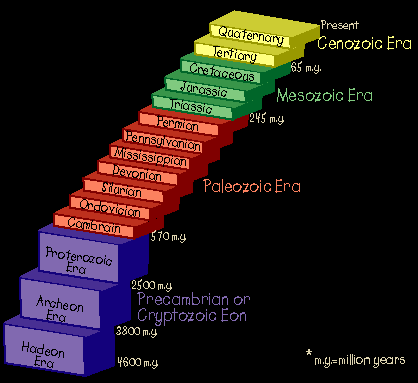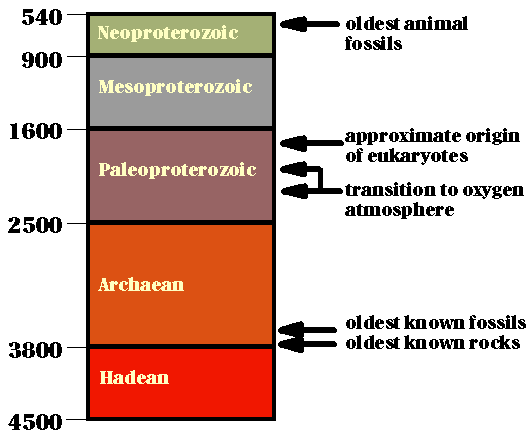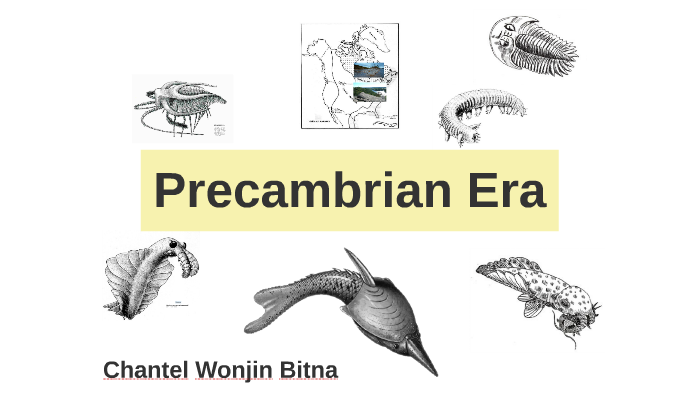No one is certain how life on Earth began but theories include the Primordial Soup Theory Hydrothermal Vent Theory and Panspermia Theory. It wasnt until the end of Precambrian Time that single-celled organisms came into existence.
By the Carboniferous Period forests of those plants covered the land.

. During this time simple anaerobic forms of life appeared and were followed by photosynthetic forms which added oxygen to the atmosphere. It has been found in the fossil record of 34 billion years ago. What were the first life forms.
The Paleozoic Era. It is now known however that life on Earth began by the early Archean and that fossilized organisms became more and more abundant throughout Precambrian time. The oldest undisputed fossils are bacteria and blue-green algae found in northwestern Australia.
The Precambrian was originally defined as the era that predated the emergence of life in the Cambrian Period. They were the primitive organisms which were capable of conducting photosynthesis and producing oxygen. One of the great difficulties of the Neo Darwinian evolutionary theory is how to explain the sudden transition from the soft bodied life forms in the sedimentary layers called the Pre Cambrian to the vast variety of hard bodied life forms in the Cambrian.
Check your knowledge Precambrian Review your notes. The Precambrian is so named because it preceded the Cambrian the first period of the Phanerozoic Eon which is named after Cambria the Latinised name for Wales where rocks from this age were first studied. What happened during the Precambrian explosion.
The first were possibly chemotrophs existing in an anoxic world and producing H2S or CO2 which were followed by photosynthetic cyanobacteria before the end of the Archaean some 25 billion years ago. Amino acids were essential for the origin of life. The Precambrian Era comprises all of geologic time prior to 600 million years ago.
How is that important to evolution. Small ocean invertebrates called trilobites became abundant. Describe Earths early atmosphere.
The earliest living organism in the Precambrian time was the Cynobacteria. Although many varied forms of life evolved and were preserved extensively as fossil remains in Cambrian sedimentary rocks detailed mapping and examination of Precambrian rocks on most continents have revealed that. Precambrian Era TIME PERIOD.
The end of this time span saw the rise of a few more complex animals in the oceans such as jellyfish. The Precambrian or Pre-Cambrian sometimes abbreviated pꞒ or Cryptozoic is the earliest part of Earths history set before the current Phanerozoic Eon. Can you describe the environmental conditions and forms of life in the Precambrian Supereon.
Then during the Silurian and devonian Periods of the Paleozoic Era land plants like ferns developed. The Precambrian begins with the formation of the Solar System 457 billion years ago bya and extends to the beginning of the Cambrian 540 million years ago Mya or 054 bya. The first Eon since the formation of our planet the name Hadean has been derived from the underworld god.
Precambrian time covers the vast bulk of the Earths history starting with the planets creation about 45 billion years ago and ending with the emergence of complex multicelled life-forms. They link together to form proteins. The Precambrian Supereon set up the conditions for animal life.
The Precambrian encompasses nearly 90 of the history of the Earth and around a third of the history of the Universe. The earliest life forms were prokaryotes eubacteria or archaea that evolved in the seas possibly as early as 38 Ba. They are in 35 by.
Cyanobacteria unusual worm like life-forms and marine organisms did not exist in Precambrian Time. All life-forms were long assumed to have originated in the Cambrian and therefore all earlier rocks were grouped together into the Precambrian. Describe the life-forms of the Precambrian Time There are Cynobacteria oxygen shielding complex organisms and invertibrates What evolutionary change in life-forms marked the beginning of the Paleozoic Era and what event marked the end of the era.
RNA may have been the first and only nucleic acid at the beginning of life. The only fossils from all but the last 100 million years or so of Precambrian time represent single-celled life forms. These rocks also contain the earliest stromatolites.
Over this immense time span the Solar System condensed from a cloud of dust and. Provide the approximate time span geologic changes and representative organisms of the Precambrian Supereon. Snowball Earth may have occurred during the late Precambrian and its end may have led to the explosion of life forms that developed during the Ediacaran and Cambrian.
The lifeforms that existed in the Pre Cambrian were all soft bodied. Remnants of prehistoric cyanobacteria activity are found in stromatolites and date back as far as 36 billion years ago. The beginning of this eon was marked by the emergence of life for the first time on our planet along with.
Most of the life that existed during the Precambrian Time span were prokaryotic single-celled organisms. The Precambrian Timetable Hadean. There is actually a pretty rich history of bacteria and related unicellular organisms within the fossil record.
In fact it is now thought that the first types of unicellular organisms were extremophiles in the Archaean domain. Two representatives of more than fifty. Cyanobacteria blue-green bacteria was one of the early photosynthetic organisms that lived in the oceans during the Precambrian time.
Following the Precambrian mass extinction there was an explosion of new kinds of organisms in the Cambrian Period 544505 million years agoMany types of primitive animals called sponges evolved. If so move forward to the next page. Towards the end this.
Aerobic forms of life evolved and eukaryotes appeared. Three Events How old was Earth when life first began. Precambrian rocks were originally defined to predate the Cambrian Period and therefore all life although the term Proterozoic was later coined from the Greek for early life It is now known that Precambrian rocks contain evidence of the very beginnings of life on Earthwhich based on the age of the rocks that contain the oldest evidence of life took place nearly 35 billion years.
This video introduces the major features of the Precambrian Supereon.

Precambrian Animals Animal Sake


0 Comments